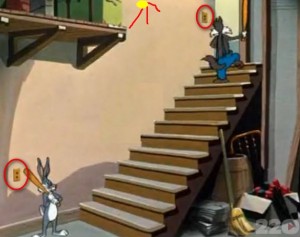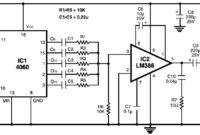This is the circuit diagram of staircase light with automatic switch off. It based on timer which is can be adjusted with the needs of the time of walking (climbing up and going down) on the staircase. We have been all acquainted with all the electrical wiring design that joins an electrical bulb with two switches: one at the bottom of a staircase and also the other at the top. Wiring is completed such that both of the two switches can be utilized to switch the light on or off. In this kind of a wiring design, whilst climbing up the staircase that is in dark, the switch positioned at the bottom of the staircase is applied to switch on the light. Right after you’ve climbed the staircase, you make use of the switch positioned there to switch off the light.
The circuit shown right here is definitely an electronic-cum-electrical design to obtain a comparable facility as given from the hard-wired electrical method, but you have to use the switch only one time. Whereas in the hard-wired design in case you forget to switch off the light after you have got traversed the staircase, light would continue to be “on,” wasting electrical power.

In this staircase light circuit also, we’ve two micro-switches-one positioned at the top area as well as the other switch placed at the bottom side of the staircase-that could be pushed and released effortlessly during climb-up from the bottom of the staircase or climbdown from the top of the staircase. With every push and release of both of the two switches, light bulb L1 lights up for a preset time period of, say, 40 seconds, that is thought to be enough for climbing up or heading down the staircase. The light bulb goes off automatically after the set 40 seconds. You’ll be able to adjust this “on” time by modifying the values of resistor R7 and/or capacitor C4 depending on your need.
Switches S1 and S2 are definitely the two micro-switches, which give low inputs towards the respective de-bouncing circuits. Every de-bouncing circuit is constructed close to two NAND gates linked back to back. The de-bouncing circuits make sure a clean, bounce-free pulse at the output each time the micro-switch is pushed and released. The outputs from the two de-bouncing circuits are ORed working with diodes D1 and D2 (1N4001). So each time you push and release both of the micro-switches, you will get a positive-going pulse at the junction of the cathodes of diodes D1 and D2.
These pulses are utilized to trigger the monostable circuit designed close to timer IC2. On the trailing edge of the pulse, the output of the monostable goes high for any time period of 40 seconds. This drives relay-driver transistor 2N2222 (T1) wired as being a switch. Relay RL1 gets energised and closes N/O contacts of the relay, wired in series with the mains and also the light bulb (L1). Light bulb L1 switches off once the relay gets de-energised right after 40-second pulse period. Free-wheeling diode D4 (1N4001) protects transistor T1 against transients during relay switch-off function.
The circuit works off a 9V battery, that gets joined towards the circuit via “on”/”off” switch S3. It is possible to also use regulated 9V power source. Build the circuit on a general-purpose PCB and keep inside a compact container. Connect micro-switches S1 and S2 close to top and bottom of the staircase by way of versatile wires and light bulb in the middle of the staircase.




